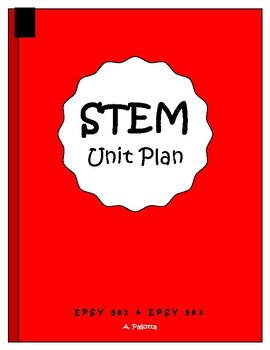STEM Unit Plan (Grade 2 Science, Mathematics, Engineering)
- PDF
Description
This unit focuses on Ecosystems: Interactions, Energy, and Dynamics.Primarily, students will focus on the element’s plants need to grow successfully.This unit is crucial for students to learn about because they acquire and apply skills from the three-dimensions of learning in science.For example, through planning and carrying out investigations (SEP), developing and using models (SEP), recognizing interdependent relationships in ecosystems (DCI), develop possible solutions to problems (DCI), and identify cause and effect relationships (CCC) and structure and functions of shapes or animals (CCC).All the goals and objectives directly connect to the content and process of these standards.They also include strategies that support NGSS and the three-dimensions of learning in science, for example, by the use of Total Participation Techniques (TPTs).This unit also integrates appropriate goals and objectives connected to the content and process standards of mathematics.Three mathematical practices are integrated (MP.2, MP.4, MP.5) and one primarily mathematic lesson.Throughout the unit, differentiation is well integrated for both gifted students and students with special needs.This is achieved through differentiation and scaffolded tasks.Students who are gifted have opportunities for extension, scaffolded tasks, or tiered activities.Students with special needs receive assistive technology, tiered activities, multiple forms of representation, action, and expression, and engagement (Universal Design for Learning Guidelines).Student engagement is ensured through the use of multiple and varied strategies to support student engagement.In using the 5E model, students are engaged throughout the lesson by participating in inquiry-based instruction, collaboration, and exploration.Each lesson includes formative assessments through monitoring checklists for task and Total Participation Techniques (TPTs).The final lesson includes a summative assessment of the 2-LS2-1 and 2-LS2-2 standards. Students are assessed in the form of an engineering task or performance.Through the use of this assessment strategy, students will have the opportunity to express their understanding through collaborating, speaking, and writing. Assessment methods accurately match intended learning targets all of the time because they use them as a basis, as well as previous student data to guide instruction. Assessment methods are varied through written responses, performance assessments, and personal communication throughout the unit.Lastly, this unit includes interdisciplinary connections aside from Science and Mathematics, these are to English Language Arts, and Engineering. Materials such as literature, media, and websites are present in the unit plan.
Students will begin the unit by viewing an anchoring phenomenon, showing a time-lapse of plant growth.To engage in inquiry, students will engage in the Questioning Formation Technique (QFT).Using this technique, students will ask and prioritize questions to get a feel for the unit.Additionally, students will communicate and discuss with others to determine what they are interested in most and what is most important to the unit.In the second lesson, students will collaborate in a science lab task, which involves planting lettuce seeds.Students will all receive different instructions on how to plant their seed.Groups will carry out investigations over 1-2 weeks to determine what plants need to grow best.This lesson is rooted in the five practices instructional strategy described for Science and Mathematical discussions.During this lesson, support is shown for the three-dimensions, as described in the objectives and standards section.The NGMS and NYS mathematical practices (MP.2, MP.4) description of the task and anticipated student responses are clearly articulated.These anticipate student responses—including correct, incorrect, and incomplete responses.The monitoring checklist carefully reviews the presence of student misconceptions.In the third lesson, students take their data collection to formulate a mathematical, graphical display.Here, students will visually express their plant growth through line plots or bar graphs.They will describe their findings and support or refute their previous understandings and predictions.This lesson integrates appropriate goals and objectives connected to content and process standards.This includes instructional strategies that support the NGMS standards, such as the 5E model, UDL principles, and differentiation. During the fourth lesson, students will experience a read aloud on the importance of bees.Upon answering questions about bumblebees’ structure and function, students will participate in an engineering task to mimic the function of the bumblebee pollination.Students will use school supplies to design and build a model that will serve the same purpose of pollinating plants.For the final lesson, students will participate in an engineering performance task, which will function as a formative assessment.Students will express their understanding of the 2-LS2-1 and 2-LS2-2 Science standards through speaking, listening, and writing.Students will complete their task, to design a diagram to answer the essential question, in groups.From this, the teacher will conclude and reflect on the overall success of the unit.





